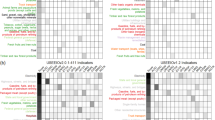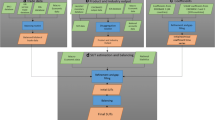Abstract
This article considers the specification and aggregation errors that arise from estimating embodied \(\text{ CO }_{2}\) emissions and embodied water use with environmentally extended national input–output (IO) models, instead of with an environmentally extended international IO model. Model specification errors result from the use of domestic environmental and domestic technology coefficients to estimate emissions or resources that are embodied in international trade. For \(\text{ CO }_{2}\) footprints, unacceptably large overestimations arise from using domestic emission coefficients, which are only partly canceled out by using domestic technology coefficients. For water use footprints both specification errors are smaller, but hardly cancel out. Sectoral aggregation errors occur when combining the 129 EXIOPOL industries to 59 EU industries and 10 broad sectors. The latter aggregation creates the largest errors. Spatial aggregation errors arise from combining 43 individual EXIOPOL countries in four broad regions and “the rest of the world”. Substantial, unacceptable errors occur again, now especially in relation to water use.
Similar content being viewed by others
Notes
The different types of aggregation errors may also interact, as noted by Su and Ang (2012).
Trade flows with the RoW are accounted for in the database, but are not included in the model presented in this paper.
Total water use in agricultural industries is the sum of the use of blue and green water. Blue water refers to rainwater evaporation; green water is ground- and surface water evaporation due to production. Agricultural water use estimates originate from the LPJmL model (Bondeau et al. 2007; Rost et al. 2008). Water use data for livestock and manufacturing industries has been modeled with the WaterGAP2 model (Alcamo et al. 2003).
We denote matrices by bold capital letters, vectors by bold lower case letters, and scalars by italicized lower case letters. A prime indicates a transposed matrix or vector. A hat indicates a diagonal matrix of this vector. The vector i is a summation vector with ones. The identity matrix I thus equals \(\hat{\mathbf{{i}}}\).
In other words, our measure represents the only possible decomposition of the errors defined here. Hence, we do not average over multiple decompositions as is generally done when alternative decompositions are possible (see e.g. Dietzenbacher and Los 1998).
We use “true” to indicate that this estimate is based on the most detailed set of data, which serves as our reference case, but which, of course, still contains unknown other errors.
The total coefficient matrix \(\mathbf{A}^{{\bullet }r}\), used here, deviates from the IO data published by the individual countries due to the estimation method of the international IO table (see Bouwmeester and Oosterhaven 2009). The country-by-country trade flows have been made consistent by revaluing them in basic prices of the producing (i.e., exporting instead of importing) country.
We present the differences between their DTA model and their MRIO “Transport exogenous” model. The GTAP database includes an international transport pool, which records the product being transported but not the bilateral link between the supplier and user of the transport service. In the “Transport exogenous” model, the pool is not allocated to use sectors, such that it gets treated as a final demand category, a designation that is adjusted in the “Transport endogenous” model. However, the authors issue several caveats and warn that this model should not be used to calculate consumption-based emissions without additional verification and model development.
References
Alcamo J, Döll P, Henrichs T, Kaspar F, Lehner B, Rösch T, Siebert S (2003) Development and testing of the WaterGAP 2 global model of water use and availability. Hydrol Sci J 48:317–337
Andrew R, Peters GP, Lennox J (2009) Approximation and regional aggregation in multi-regional input–output analysis for national carbon footprint accounting. Econ Syst Res 21:311
Blair P, Miller RE (1983) Spatial aggregation in multiregional input–output models. Environ Plan A 15: 187–206
Bondeau A, Smith PC, Zaehle S, Schaphoff S, Lucht W, Cramer W, Gerten D, Lotze-Campen H, Müller C, Reichstein M, Smith B (2007) Modelling the role of agriculture for the 20th century global terrestrial carbon balance. Global Change Biol 13:679–706
Bouwmeester MC, Oosterhaven J (2009) Methodology for the construction of an international supply-use table. In: Proceedings of 17th international input–output conference of the International Input–Output Association (IIOA), São Paulo, Brazil, 13–17 July 2009
Davis SJ, Caldeira K (2010) Consumption-based accounting of \(\text{ CO }_2\) emissions. Proc Natl Acad Sci 107:5687–5692
De Haan M, Keuning SJ (1996) Taking the environment into account: the NAMEA approach. Rev Income Wealth 42:131–148
Dietzenbacher E, Los B (1998) Structural decomposition techniques: sense and sensitivity. Econ Syst Res 10:307–323
Guan D, Hubacek K (2007) Assessment of regional trade and virtual water flows in China. Ecol Econ 61: 159–170
Hoekstra A, Chapagain A (2007) Water footprints of nations: water use by people as a function of their consumption pattern. Water Resour Manag 21:35–48
Hoekstra AY, Mekonnen MM (2012) The water footprint of humanity. Proc Natl Acad Sci 109:3232–3237
Isard W (1951) Interregional and regional input–output analysis: a model of the space economy. Rev Econ Stat 33:318–328
Kanemoto K, Lenzen M, Peters GP, Moran DD, Geschke A (2012) Frameworks for comparing emissions associated with production, consumption, and international trade. Environ Sci Technol 46:172–179
Kymn KO (1990) Aggregation in input–output models: a comprehensive review, 1946–71. Econ Syst Res 2:65–93
Lenzen M (2011) Aggregation versus disaggregation in input–output analysis of the environment. Econ Syst Res 23:73
Lenzen M, Pade L, Munksgaard J (2004) \(\text{ CO }_2\) multipliers in multi-region input–output models. Econ Syst Res 16:391–412
Lenzen M (1998) Primary energy and greenhouse gases embodied in Australian final consumption: an input–output analysis. Energy Policy 26:495–506
Lutter S, Giljum S, Acosta J, Wittmer D, Kuenen J, Pulles T (2010) Documentation (technical report) of data sets compilation for environmental extensions. EXIOPOL deliverable DIII.2.b-2 and DIII.3.b-2
Miller RE, Blair PD (2009) Input–output analysis: foundations and extensions. Cambridge University Press, Cambridge
Narayanan GB, Walmsley TL (eds) (2008) Global trade, assistance, and production: the GTAP 7 data base. Purdue University, Center for Global Trade Analysis
Peters GP, Hertwich EG (2008) Post-Kyoto greenhouse gas inventories: production versus consumption. Clim Change 86:51–66
Peters GP (2008) From production-based to consumption-based national emission inventories. Ecol Econ 65:13–23
Peters GP, Andrew R, Lennox J (2011) Constructing an environmentally-extended multi-regional input–output table using the GTAP database. Econ Syst Res 23:131–152
Rost S, Gerten D, Bondeau A, Lucht W, Rohwer J, Schaphoff S (2008) Agricultural green and blue water consumption and its influence on the global water system. Water Resour Res 44:1–17
Serrano M, Dietzenbacher E (2010) Responsibility and trade emission balances: an evaluation of approaches. Ecol Econ 69:2224–2232
Su B, Ang BW (2010) Input–output analysis of \(\text{ CO }_2\) emissions embodied in trade: the effects of spatial aggregation. Ecol Econ 70:10–18
Su B, Ang BW (2011) Multi-region input–output analysis of \(\text{ CO }_{2}\) emission embodied in trade: the feedback effects. Ecol Econ 71:42–53
Su B, Ang BW (2012) Structural decomposition analysis applied to energy and emissions: aggregation issues. Econ Syst Res 24:299–317
Su B, Huang HC, Ang BW, Zhou P (2010) Input–output analysis of \(\text{ CO }_2\) emissions embodied in trade: the effects of sector aggregation. Energy Econ 32:166–175
Tukker A, Poliakov E, Heijungs R, Hawkins T, Neuwahl F, Rueda-Cantuche JM, Giljum S, Moll S, Oosterhaven J, Bouwmeester M (2009) Towards a global multi-regional environmentally extended input–output database. Ecol Econ 68:1928–1937
Wiedmann T (2009) A review of recent multi-region input–output models used for consumption-based emission and resource accounting. Ecol Econ 69:211–222
Wiedmann T, Lenzen M, Turner K, Barrett J (2007) Examining the global environmental impact of regional consumption activities—part 2: review of input–output models for the assessment of environmental impacts embodied in trade. Ecol Econ 61:15–26
Wiedmann T, Wilting HC, Lenzen M, Lutter S, Palm V (2011) Quo Vadis MRIO? Methodological, data and institutional requirements for multi-region input–output analysis. Ecol Econ 70:1937–1945
Wood R, Hawkins T, van Bree T, Poliakov E (2010) Development of harmonized supply and use tables for the EXIOPOL database, and, consumption activities and waste in EXIOBASE. EXIOPOL deliverable DIII.2.a, DIII.3.a, DIII.2.c.2 and DIII.2.c.3
Wyckoff AW, Roop JM (1994) The embodiment of carbon in imports of manufactured products: implications for international agreements on greenhouse gas emissions. Energy Policy 22:187–194
Yu Y, Hubacek K, Feng K, Guan D (2010) Assessing regional and global water footprints for the UK. Ecol Econ 69:1140–1147
Acknowledgments
This work is part of the EXIOPOL project (http://www.feem-project.net/exiopol), an integrated project funded by the European Union, under Framework Programme 6, Priority 6.3 Global Change and Ecosystems, Grant agreement no. 037033-2. We thank our partners for their cooperation and Arnold Tukker, the project leader, for stimulating comments. We also thank Richard Wood, Glen Peters, an anonymous referee, and the editor, Christian Vossler, for their comments on earlier versions of the paper, and Elisabeth Nevins Caswell for editing our English.
Author information
Authors and Affiliations
Corresponding author
Appendices
Appendix 1
Appendix 2
Appendix 3
Appendix 4
Rights and permissions
About this article
Cite this article
Bouwmeester, M.C., Oosterhaven, J. Specification and Aggregation Errors in Environmentally Extended Input–Output Models. Environ Resource Econ 56, 307–335 (2013). https://doi.org/10.1007/s10640-013-9649-8
Accepted:
Published:
Issue Date:
DOI: https://doi.org/10.1007/s10640-013-9649-8




